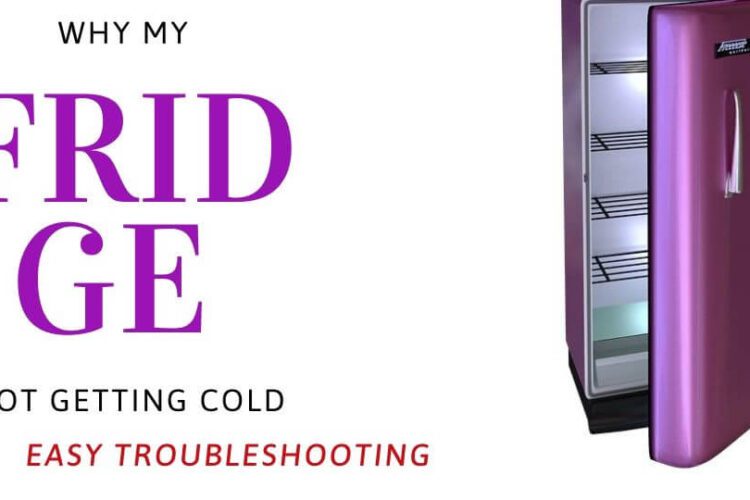Why My Fridge Not Getting Cold?
Topic: Why My Fridge Not Getting Cold?
A Complete Guide to Reasons, Solutions, and When to Say Goodbye
If you are questioning the functionality of your refrigerator or freezer, a good place to start is to know the answer to the question: “How cold should the refrigerator be?” According to the FDA, a refrigerator must have a temperature of 40 ° F or less, while a freezer must have a temperature of 0 ° C.
Is your refrigerator not chilling or preserving your food? Our team at Shree Appliance can help you diagnose your potential problem, guide you through the repair steps, and explain when to return and let a professional handle it.
Easy checking things in the first place.
Sometimes nothing breaks in your fridge, even though it’s not great. These “easy solutions” are steps you can take to protect yourself from embarrassing conversations with a repair technician and any unnecessary service charges.
- There is no plugin in the fridge. This may sound silly, but an alarming number of people conclude without stopping to check if the energy is reaching their refrigerator as well. Don’t be one of those people.
- The thermostat is removed. Again, this may sound obvious but trust us. Locate your thermostat and verify that it is set to the proper temperature. Side-by-side freezer/refrigerator thermostats are generally located at the rear, while top-down units probably have their thermostats at the bottom of the refrigerator.
- The door does not close properly. Check doors and gaskets. Does the refrigerator light stay on and off when you close the door? Otherwise, the door may not function properly. The gasket, a flexible elastic strip around the door edges designed to seal closed doors, can tear and leak hot or humid air into the refrigerator. If your gasket is broken, you should replace it and see if your refrigerator stays cold.
- Cold air cannot circulate. If food boxes are blocking ventilation, cold air communication through your refrigerator may be interrupted. Tune-up your refrigerator or remove some foods that may block airflow and keep it from getting cold.
If you go through this checklist and the temperature in your fridge or freezer is still not there, it shouldn’t happen, you may face a more complex problem. There have been indications that your hot refrigerator is more troublesome than a crowded freezer, and our team tells you what to look for!
Why My Fridge Not Getting Cold?
Refrigerator problems and how to fix them in an easy way.
A hot refrigerator is not always an obvious solution. There are many different things that can cause this problem. Defective parts can be difficult, especially when you need to find out which part is causing the problem. Our Appliance technicians have listed common refrigerator and freezer problems, where they occur, and how you can fix them.
Fridge compressor
The compressor is the part of the refrigerator that compresses and pushes the refrigerant vapor into the coil out of the refrigerator. Pushing and pressing creates heat, creating hot gases that subsequently cool and absorb heat from the freezer and refrigerator.
If the freezer fan continues to run, but your refrigerator is not cooling, your compressor or compressor start relay may malfunction.
- Where it is located: The compressor is located behind and below your refrigerator. It is a black part, in the form of a tank. The compressor start relay is the part that supplies the cables to the compressor. To get to both sides, you will need to move your refrigerator away from the wall. Be sure to disconnect your refrigerator from its power source before you begin.
- Solution for the same: Replacing the compressor start relay is much easier and cheaper than replacing the compressor. Simply purchasing a new relay and testing it with your current compressor will highlight if you will need a new compressor or if your current problem is fixed. To replace the compressor, it must be safely disconnected from the suction line and discharge line of the compressor. You will need to remove the electrical package and cut the high and low lines before loosening the bolts that hold the compressor in place. You can move the part closer to reach and remove the ground wire. Your new compressor will need to be connected to your suction line, discharge line, and process line. Welding will be required to secure the lines in place. Transfer the rubber washers from your old compressor to the new one and switch to the crossover line before emptying the new system and unloading the new load.
Capacitor coil
The condenser coil carries the hot gas produced by the compressor to the evaporator coil. As the coolant travels through the coil at high pressure, it cools and turns into a liquid again. Closed condenser coils can cause poor air circulation, limiting the ability to keep your refrigerator cool.
- Where they are: The condenser coils are located under or on the back of the fridge. They move from the compressor to the freezer.
- Solution for the same: If your coils are full, they may need cleaning. Disconnect refrigerator from electrical power before removing grill (see owner’s manual to see if grill can be removed directly without any additional steps). Using a coil brush, push the tool into the condenser coil and remove any accumulated dust there. You can then vacuum the powder and reinstall your toe.
Condenser Fan
The condenser fan cools the compressor and condenser coil while they run. The fan must be running when the compressor is running. If the condenser fans do not function properly, the refrigerator temperature may increase, and the compressor may become hot.
- Find its location: The condenser fan is located in the bottom cabinet next to the compressor and condenser coil. It is important to note that the refrigerator will not have a fan with a condenser coil on the back.
- Solution for the same: First, make sure the condenser fan is spinning freely and is not obstructed by any object. Dust or other objects may prevent the blades from rotating as required. If there is nothing preventing the blade from rotating, you may need to replace the condenser fan motor. You can purchase a new fan motor from a local appliance parts dealer or refrigerator manufacturer. To replace the motor, simply remove the mounting screw that holds the fan and carefully remove the case from the motor compartment. Remove the mounting bracket that holds the old motor on the blade, replacing it with your new motor.
Evaporator Fan
The evaporator fan is the part of the refrigerator that expels the cold air you feel as soon as you open the door. This evaporator draws air through the coil, cools it, and then pushes air through the freezer and refrigerator. If the evaporator fan does not run or runs when the compressor does, your unit will not be able to produce cold air.
- Find its location: The evaporator fan is located behind the wall of your freezer. Before you can access it, you must empty the contents and the shelves of your freezer.
- Solution for the same: If the fan is not working, you may need to replace the fan motor. After removing the evaporator panel on the back of the freezer, locate the fan and remove the mounting clip, fan blade, and wire harness. Install the new motor in the wiring harness and insert the motor into the housing. Insert the fan blade fully and reapply the mounting clip. Replace the evaporator panel and put it in the freezer.
Tipper air
The air regulator controls the amount of cold air that is shared from the freezer to the refrigerator. If the air regulator cannot be closed or opened, it can affect the temperature of the refrigerator while the freezer is kept at the correct temperature. When the air tipper cannot be opened, cold air cannot pass from the freezer to the refrigerator compartment, causing it to heat up.
- Where it is located: It is located between the fresh food compartment and the freezer in your refrigerator. In a side-by-side freezer/refrigerator, the air tipper should be located in the upper left corner of the refrigerator.
- Solution for the same: Remove the air damper by removing any type of screw holding the drain cover or sponge cover, and remove the cover. The thermostat sensor will be around the tipper, which can easily take off. In the freezer, remove the ice cube if you have one. There will be a motor that can be unscrewed and unplugged to remove it from the compartment. Unclip the rear duct panel that holds the air tipper in place. Remove the old one and install a new air regulator, replacing all the compartments that you have removed in the process.
when all else fails
If you are having trouble diagnosing the problem or have no experience replacing and repairing mechanical parts, there is no shame in calling a professional to fix it. Kitchen appliances can be tricky, and we certainly don’t recommend that you separate your refrigerator if you don’t know what you’re doing. Not only can it cause more damage to your expensive equipment, but it can also be incredibly dangerous.
At Shree Appliance, our team of repair specialists understands how to repair your unit quickly and effectively. If in doubt, call our comprehensive repair services to help you avoid refrigerating your refrigerator or any other issues you may be facing.
Say goodbye to your unit.
There are a few examples where your refrigerator may be past the point of return (or at least, it will always repair your current one rather than just buying a new unit for less money). So how do you know when your fridge is on its last leg, you need a tune instead?
Most consumer reports recommend that the age of your unit and the cost of its repair service are the best guidelines for replacing your refrigerator.
Although lifespan depends on unit type, units generally need to be repaired first:
- 7 years for the bottom freezer with additional future repairs
- 5 years for side by side refrigerators/freezers with additional future repairs
- 3 years for top freezers with additional repairs 3-6 years to 7 years after replacement
The general rule of thumb should be until your refrigerator has sentimental value, choose a new unit as long as the repair exceeds the cost of buying a new unit!




